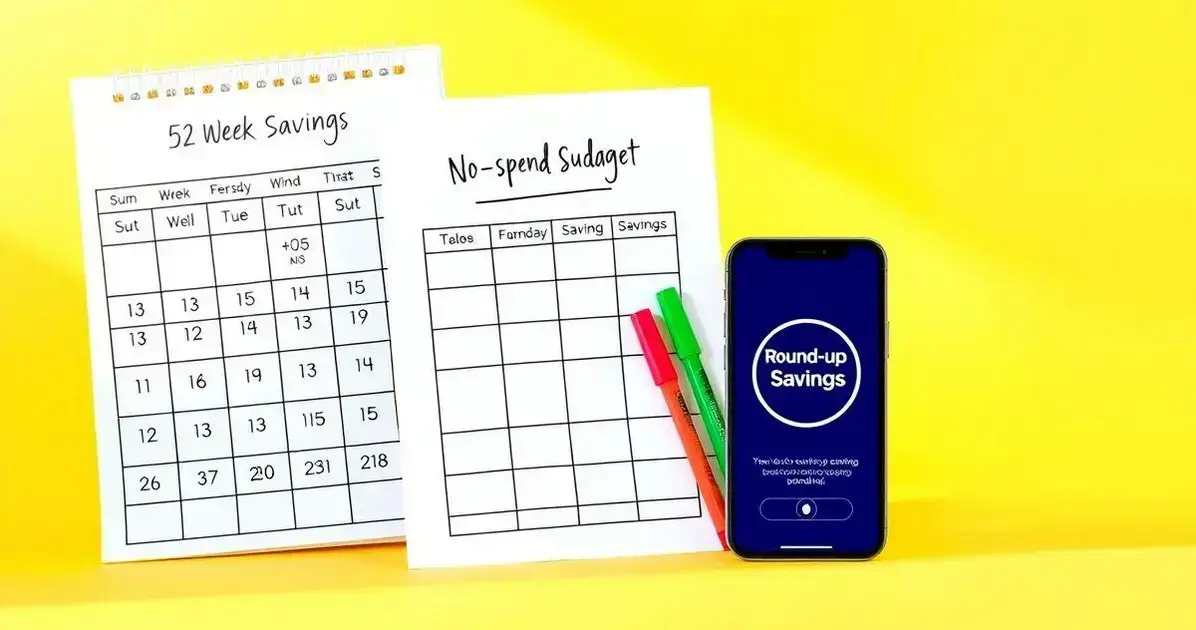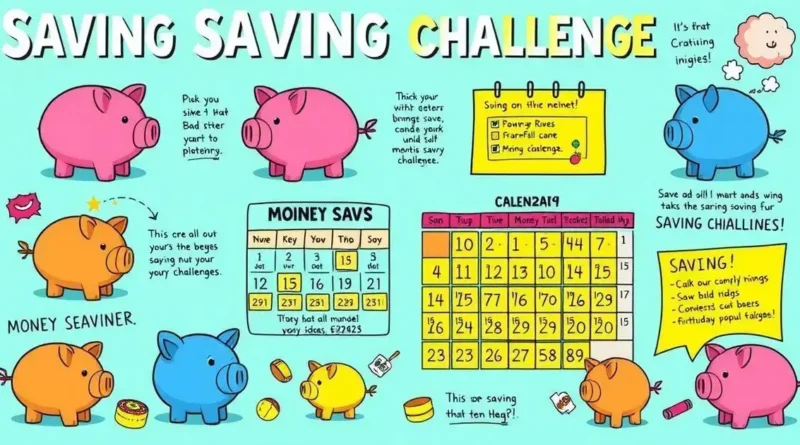Saving Challenges That Actually Work: 9 Effective Ways to Boost Your Savings
Are you tired of trying to save money without seeing results? Saving challenges that actually work can transform your financial habits into effective money-saving strategies.
From small monthly commitments to innovative yearly challenges, there’s a saving method that suits everyone.
In this article, we will discover various challenges that can help you save effectively, stay motivated, and achieve your financial goals faster.
Introduction to Saving Challenges
Saving challenges are fun and creative ways to help you put aside money. They allow you to set goals and make saving a game. Instead of just putting extra cash in a piggy bank, you can take on specific tasks that make the process more exciting.
Many people find that when they turn saving into a challenge, they stick with it longer. These challenges can be daily, weekly, or monthly, and can fit any budget.
By forming good habits through these activities, you’ll not only reach your savings goal but also feel a sense of achievement along the way.
Would you like to try something new with your savings? Saving challenges that actually work can help you start today! They are simple to follow and designed to motivate you.
Whether you save small amounts repeatedly or tackle bigger challenges, you’ll find a method that suits you and boosts your savings effectively.
Benefits of Saving Challenges
Saving challenges offer many benefits that can change how you manage your money. First, they help you set clear goals. By having a specific amount to save and a time frame, you can track your progress easily. This makes saving less of a chore and more like a fun mission.
Another great benefit is the sense of community that comes with saving challenges. Many people join groups or online forums to share their goals.
This connection can give you support and encouragement from others who are on the same journey. Sharing your wins, no matter how small, can motivate you to keep going.
Lastly, participating in saving challenges can teach you about your spending habits. As you save more, you become more aware of where your money goes.
This awareness helps you make better choices in the future, leading to healthier financial habits overall. You not only boost your savings, but also become smarter with your finances!
How to Choose the Right Challenge
Choosing the right saving challenge starts with understanding your financial goals. Think about how much money you want to save and in what time frame. A simple challenge, like saving a dollar a day, might be perfect for beginners.
If you’re looking to save more quickly, try a challenge where you increase your savings each week to keep it exciting.
Next, consider your lifestyle and habits. Some challenges may require strict discipline, while others can be more flexible. Make sure to pick a challenge that fits comfortably within your daily life.
If you often spend without thinking, choose a challenge that encourages mindfulness about spending.
Finally, don’t hesitate to get creative! You can mix and match different challenges or even create your own. Personalizing your saving challenge makes it more fun and keeps you motivated. Remember that the goal is to make saving enjoyable while reaching your financial targets.
Popular Saving Challenges

Many people enjoy the 52-week saving challenge because it’s simple and effective. You start by saving just one dollar in the first week and increase that amount by a dollar every week.
By the end of the year, you’ll have saved a total of $1,378. This gradual increase makes it easier to stick with the challenge without feeling overwhelmed.
Another popular option is the no-spend challenge. In this variation, you commit to not spending any money on non-essential items for a set period, usually a month.
This helps you save a considerable amount while also becoming more aware of your spending habits. You’ll learn to prioritize what you truly need versus what you want, which can have long-term benefits.
The round-up challenge is great for those who use a bank account or app that allows you to round up purchases to the nearest dollar. The extra change gets saved automatically.
For example, if you spend $3.75, the bank rounds it up to $4 and saves the $0.25. Over time, these small amounts add up without requiring much effort on your part.
Monthly Saving Challenge Ideas
One fun idea for a monthly saving challenge is the 30-day $1 challenge. In this challenge, you save $1 on the first day, $2 on the second day, and continue this pattern until the last day of the month.
By the end of the month, you will have saved $465! This method keeps you motivated with daily goals that are easy to manage.
Another great option is the monthly themed challenge. Each month, pick a theme to guide your savings. For example, in January, focus on saving for health by putting aside money to buy healthier groceries.
In February, you might save for gifts or date nights. These themes keep your savings fresh and relevant to your life!
A third idea is the automatic monthly transfer challenge. Set up an automatic transfer from your checking to your savings account each month. Start small with $20 and gradually increase the amount.
This way, you build your savings without having to think about it, making it a hassle-free and effective way to grow your funds.
Yearly Savings Challenges
The annual savings challenge is a powerful way to grow your savings over the year. Start by setting a specific goal for what you want to save by the end of the year. This could be for a vacation, a new car, or an emergency fund.
Break this goal into monthly or weekly amounts, so you know exactly how much to save regularly. Keeping track of your progress can motivate you to stick with it.
Another exciting option is the yearly bucket challenge. In this challenge, you create different buckets for various savings goals. For example, you might have a bucket for travel, one for home improvements, and another for holiday gifts.
Each month, allocate a specific amount to each bucket. This method allows you to save for multiple things at once, making your goals more varied and fun.
Lastly, consider the year-long declutter challenge as a unique way to save money. Each month, pick an area in your home to declutter and sell items you no longer need.
Use the money you make from these sales to add to your savings. Not only will you be saving money, but you’ll also create a more organized and tidy living space!
Unique Variations on Saving Challenges
One unique variation on saving challenges is the penny challenge. In this challenge, you save one penny on the first day, two pennies on the second day, and continue to add a penny each day for a full year.
By the end of the year, you will have saved over $600! This method is engaging because it starts small, allowing you to gradually increase your savings without feeling the pinch right away.
Another creative option is the swap challenge. In this challenge, you swap a bad habit for a saving habit. For example, if you usually buy a coffee each morning, skip it for a week and save that money instead.
By the end of the week, you’ll see how much you can save just by making simple changes to your daily routine.
Lastly, try the reverse savings challenge. Instead of saving a certain amount each week, you start by saving a larger amount in the first week, like $52, and decrease the amount by $1 each week.
By the end of the year, you will have saved the same total as with the traditional challenge but in a way that could feel easier at the start of the year.
Tracking Your Savings Progress
![]()
Tracking your savings progress is crucial to achieving your financial goals. One effective way to do this is by using a visual savings tracker.
You can create a chart or graph that shows your savings goals and how much you’ve saved each month. Seeing your progress visually can be motivating and help you stick to your challenge.
Another smart tool is to use a savings app or software. Many apps allow you to set goals and automatically track your savings. These apps can provide updates and reminders, making it easier to stay on track. With notifications to celebrate milestones, you’ll feel encouraged as you save.
Finally, consider keeping a savings journal. In this journal, you can write down your savings goals, the amounts saved each week, and how you feel about your progress.
Reflecting on your journey is not only helpful for motivation but can also reveal patterns in your saving habits that you can improve in the future.
Tips for Sticking to Your Challenge
One effective tip for sticking to your saving challenge is to set clear and realistic goals. When you define your savings target, make it specific and achievable.
Instead of saying you want to save money, specify how much you’d like to save in a month or over the year. Having clear goals helps you stay focused and gives you a sense of purpose.
Another great strategy is to find an accountability partner. Share your savings goals with a friend or family member who can support you throughout your challenge.
Regular check-ins and shared progress can keep both of you encouraged and motivated to stay on track. It’s always easier to stick with something when someone else is on the journey with you!
Lastly, make your saving challenge fun and engaging! Reward yourself for reaching milestones, no matter how small. Whether it’s treating yourself to a small coffee or having a fun day out, celebrating achievements can make the process enjoyable.
The more fun you have, the more likely you are to stick with your savings challenge.
Setting up a savings challenge can be exciting, but following through is the key to success. One effective way to maintain your focus is to create a visual reminder of your goal.
You might use a poster, whiteboard, or digital app that tracks your progress. Seeing your savings grow day by day can motivate you to stick to the challenge.
Another helpful tip is to establish small routines that incorporate your saving habits. For example, you could dedicate a specific day of the week to review your expenses and savings. This habit not only keeps you accountable but also allows you to adjust your goals if necessary.
Lastly, make sure to celebrate your milestones along the way! When you reach a significant savings goal, reward yourself with a small treat or fun activity. This will build positive reinforcement and help you stay committed. Remember, each step forward is progress!
